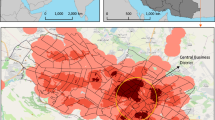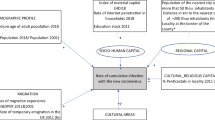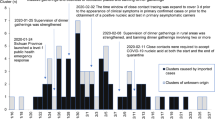Abstract
Since the first official report of the spread of SARS-CoV-2 infections in the city of Qom in mid-February, Iran has become the country most affected by the COVID-19 epidemic in the Middle East. All Iranian provinces are now affected, although to a different extent. The aim of the present study was to evaluate whether the distance from the epicenter of the infection (Qom) or demographic factors such as population density and the ratio of the elderly population are associated with the incidence of COVID-19 in different Iranian provinces. For the purpose of determining whether the distance from the virus epicenter could be associated with the spread of infection, linear regression analysis was performed using STATA 12.0 software. The association of the incidence of COVID-19 with the population density and the ratio of the population over 65 years old in 31 Iranian provinces was also evaluated. According to our results, a strong association was found between the incidence of COVID-19 in Iranian provinces and their respective distance from Qom (p < 0.001; C = -0.68). The incidence of COVID-19 in Iranian provinces was also positively associated with the ratio of the population over 65 years old (p = 0.002; C = 0.53), while no significant association with population density was found (p = 0.39; C = 0.16). These results suggest that the implementation of travel restrictions from highly affected areas to other provinces could considerably reduce the rate of transmission of the disease throughout the country. Also, provinces with a higher proportion of elderly people (over 65) were identified as particularly at risk for the spread of SARS-CoV-2 infections. These results will contribute to better management of the COVID-19 outbreak in Iran, taking into account demographic and geographic characteristics of different provinces.
Similar content being viewed by others
Introduction
With a population of about 83,075,000 inhabitants, Iran was the country most affected by the coronavirus disease 2019 (COVID-19) epidemic in the Middle East. Located in southwestern Asia and bounded by the Caspian Sea to the north and the Persian Gulf to the south, Iran is at the crossroads between Europe, the Middle East, and Asia. Its central location in Eurasia, spanning over an area of 1,648,000 square kilometers, accounts for its strategic geographic importance. Iran has a mean population density of 52 inhabitants per square kilometer. However, the population density varies considerably throughout the country due to the presence of a vast unpopulated central desert plateau and massive mountain ranges, which occupy most of the land area. The northern provinces of Tehran, Alborz, Gilan, Mazandaran, and Qom have the highest population density among the 31 Iranian provinces (Table 1).
Iran announced its first cases of SARS-CoV-2 infection in the city of Qom (the capital of Qom province) on 19 February 2020 [1, 2]. Despite the relatively rapid identification of the source and area of the infection, no city has been isolated or locked down, and the virus quickly spread throughout the country [3, 4]. According to the latest assessment by the Iranian health authorities, 232,863 cases have been confirmed, and 11,106 patients have died (http://behdasht.gov.ir). At least six neighboring countries, including Iraq, Pakistan, Bahrain, Oman, Kuwait, and Afghanistan, had reported imported cases of COVID-19 from Iran [5]. However, this is only a partial picture of the situation in the region, as the number of cases of COVID-19 was underreported in many countries due to inadequate screening of suspected cases and a shortage of diagnostic kits [6]. According to official Iranian data, the first reported cases of COVID-19 were in Qom [4, 7], a holy city near the capital Tehran and a major destination of pilgrimages in the region [8]. In the absence of a city-wide lockdown, COVID-19 spread very quickly to adjacent provinces such as Tehran, Isfahan, and Markazi [3, 9]. In late February, the Iranian authorities decided on a set of measures aimed at limiting the spread of disease, such as the closure of educational institutions, major religious sites, and public monuments, as well as the cancellations of events giving rise to rallies. Furthermore, substantive information and education programs have been carried out at both the local and national level to improve practices and people’s knowledge regarding COVID-19 [7, 10].
Faced with the growing COVID-19 epidemic and the wave of departure throughout the country due to the Nowruz holidays, travel between cities was prohibited starting 27 March 2020, a week after the Iranian New Year’s vacation. However, according to the Iranian Red Crescent, three million people had left the thirteen provinces most affected by COVID-19 by road since 17 March 2020 [11]. In addition, about 136,400 Afghans returned to Afghanistan by land just before the implementation of travel restrictions [12]. According to GIS-based maps, the spread of COVID-19 throughout Iran mainly occurred from the north-central provinces of Qom and Tehran [4].
Through regression analysis, this study aimed to evaluate whether the distance of different Iranian provinces from the epicenter of the infection (Qom) was associated with the incidence of COVID-19 at the early stages of the epidemic in Iran. The association of the disease with the population density and the ratio of the population over 65 years old was also evaluated and compared.
Materials and methods
Study population and incidence data
With a population of about 83,075,000 inhabitants and a total land area of 1,628,550 km2, Iran became the epicenter of the COVID-19 epidemic in the Middle East and Central Asia. COVID-19 has spread to all 31 Iranian provinces, and the city of Tehran, the densely populated capital with over 13 million people located 150 km northeast of Qom, leads the country in COVID-19 cases (Table 1). The incidence rate for each province was calculated as the number of COVID-19 cases diagnosed until 23 March 2020 divided by the population of the province in 2019 and multiplied by 100,000. The number of COVID-19 cases diagnosed until 23 March 2020 in each province was provided by the Iranian Ministry of Health and Medical Education (available from: http://behdasht.gov.ir/). The population and demographic data of the Iranian provinces were extracted from the census results and official 2019 projections provided by the Statistical Centre of Iran (www.amar.org.ir). Demographic data and COVID-19 incidence rates for the 31 Iranian provinces are listed in Table 1. The present study (ID 1398.471) was approved by the ethics committee of the Hormozgan University of Medical Sciences. It did not involve human samples or participants.
Statistical analysis
Pearson’s correlation coefficient (r) was measured in order to determine the linear association between variables. The assumption of normality of the data distribution was checked using the Kolmogorov-Smirnov (KS) test prior to analysis. The statistical significance at the 5% level was evaluated. Wald p-values and the corresponding 95% confidence intervals are presented for the impact of independent linear and categorical items. One-way ANOVA was used to determine the statistical significance of differential incidence rates of COVID-19 reported in Iranian provinces based on their relative distances from Qom. Figure 1 was produced using R version 3.3. All other analyses were performed using STATA software, version 12.0 (STATA Corp, College Station, TX, USA) [13].
Results
All 31 Iranian provinces were affected. However, they were impacted to varying degrees. Tehran, the highly populated capital and the largest city in the country, reported the largest number of coronavirus cases. However, its incidence rate per 100,000 people is not the highest and was topped by the less densely populated provinces of Semnan, Qom, Markazi, Yazd, Mazandaran, Qazvin, Guilan, Alborz and Isfahan (Fig.1, Table 1).
The present study revealed a highly significant association between the incidence of COVID-19 infections in Iranian provinces and their respective distance from Qom (p < 0.001; C = -0.68) (Fig. 2). The majority of COVID-19 cases (65%) were centered in an area of 350 km around Qom, with an average incidence of 47 per 100,000 people (Table 2). One-way analysis of variance (ANOVA) showed statistically significant differences in the COVID-19 incidence between the Iranian provinces (Table 3) located in an area of 350 km around Qom Province and those at a distance of 350 to 700 km (p = 0.003) and more than 700 km (p < 0.001). The incidence of COVID-19 in the Iranian provinces was positively associated with the ratio of the population over 65 years old (p = 0.002; C = 0.53), while no significant association was shown with population density (p = 0.39; C = 0.16) (Fig. 3).
Discussion
After the first two months of the epidemic of COVID-19 in Iran, the country faces serious threats due to the rapidly growing epidemic and rising incidence of COVID-19 in different Iranian provinces, most of which are not as well equipped and prepared as the capital city, Tehran, to cope with the increasing numbers involved. Unlike many affected countries, strict containment and mass quarantine regulations have not been implemented in Iran since the first official report of the spread of SARS-CoV-2 infections in the city of Qom in mid-February. Through linear regression analysis, the present study tried to determine the relationship between the incidence of COVID-19 in Iranian provinces and their respective distance from the virus epicenter (Qom). Although the incidence per 100,000 inhabitants was higher in densely populated areas (Table 2; Fig. 3), this association was not significant (p = 0.39; C = 0.16). It seems, therefore, that the density of the population does not itself drive the spread of the disease, as indicated by the lower incidence of COVID-19 in Tehran when compared to the less densely populated provinces of Semnan, Qom, Markazi, Yazd, Mazandaran, Qazvin, Guilan, Alborz and Isfahan (Fig.1, Table 1). Thus, other demographic and environmental factors may explain the differences in vulnerability to the COVID-19 epidemic among the Iranian provinces. Our statistical analyses showed that the association between the incidence of COVID-19 in Iranian provinces and their respective distance from Qom is highly significant. This indicates that the implementation of strict travel restriction from highly affected areas to other provinces could considerably reduce the rate of transmission of the disease throughout the country. The Chinese experience showed that the home-based quarantine of people living in Hubei province (the epicenter of the epidemic) and strict travel policies, extended even long after the Lunar New Year holiday, have been particularly helpful in controlling of the transmission of the disease to the wider community and other provinces [14].
Iranian provinces with an aging population were identified as particularly at risk for the spread of COVID-19. Age distribution has previously been shown to significantly influence the case-fatality rate due to the epidemic [15, 16]. In this respect, it has been proposed that the older population is particularly at risk because of reduced immune function [17]. In Iran, older age and having comorbidities were strongly correlated with the risk of death among patients suffering from COVID-19 [18]. This highlights the need to implement proactive measures to protect the health of the elderly population from COVID-19 with a special emphasis on physical distancing and hygienic measures for individuals exposed to higher risks [2, 19,20,21]. This is a challenge that is coupled with a moral and social responsibility to take care of the health, morals, and safety of our elders in the view of the effectiveness and sustainability of the efforts in tackling the pandemic [17].
To conclude, we found a negative linear association between the incidence of COVID-19 in Iranian provinces and their respective distance from Qom. Our regression analysis showed that the relationship between the variables is strong (p < 0.001; C = -0.68). The incidence of COVID-19 in Iranian provinces was also positively associated with the ratio of the population over 65. These data stress the need for preventive and monitoring measures to counter the spread of the disease throughout the country, taking into account demographic and geographic characteristics of different provinces.
References
Takian A, Raoofi A, Kazempour-Ardebili S (2020) COVID-19 battle during the toughest sanctions against Iran. Lancet (London, England) 395(10229):1035. https://doi.org/10.1016/S0140-6736(20)30668-1
Malik YS, Sircar S, Bhat S, Sharun K, Dhama K, Dadar M, Tiwari R, Chaicumpa W (2020) Emerging novel coronavirus (2019-nCoV)—current scenario, evolutionary perspective based on genome analysis and recent developments. Vet Q 40(1):68–76. https://doi.org/10.1080/01652176.2020.1727993
Abdi M (2020) Coronavirus disease 2019 (COVID-19) outbreak in Iran: actions and problems. Infect Control Hosp Epidemiol. https://doi.org/10.1017/ice.2020.86
Arab-Mazar Z, Sah R, Rabaan AA, Dhama K, Rodriguez-Morales AJ (2020) Mapping the incidence of the COVID-19 hotspot in Iran—implications for travellers. Travel Med Infect Dis 34:101630. https://doi.org/10.1016/j.tmaid.2020.101630
Zhuang Z, Zhao S, Lin Q, Cao P, Lou Y, Yang L, He D (2020) Preliminary estimation of the novel coronavirus disease (COVID-19) cases in Iran: a modelling analysis based on overseas cases and air travel data. Int J Infect Dis 94:29–31. https://doi.org/10.1016/j.ijid.2020.03.019
Zhao S, Musa SS, Lin Q, Ran J, Yang G, Wang W, Lou Y, Yang L, Gao D, He D (2020) Estimating the unreported number of novel coronavirus (2019-nCoV) cases in China in the first half of January 2020: a data-driven modelling analysis of the early outbreak. J Clin Med 9(2):388. https://doi.org/10.3390/jcm9020388
Honarvar B, Lankarani KB, Kharmandar A, Shaygani F, Zahedroozgar M, Haghighi MRR, Ghahramani S, Honarvar H, Daryabadi MM, Salavati Z (2020) Knowledge, attitudes, risk perceptions, and practices of adults toward COVID-19: a population and field-based study from Iran. Int J Public Health. https://doi.org/10.1007/s00038-020-01406-2
Seyfi S, Hall CM (2018) Tourism in Iran: challenges, development and issues. Routledge, Abington
Hoseinpour Dehkordi A, Alizadeh M, Derakhshan P, Babazadeh P, Jahandideh A (2020) Understanding epidemic data and statistics: a case study of COVID-19. J Med Virol 92(7):868–882. https://doi.org/10.1101/2020.03.15.20036418
Ahmadi A, Shirani M, Rahmani F (2020) Modeling and forecasting trend of COVID-19 epidemic in Iran. medRxiv. https://doi.org/10.1101/2020.03.17.20037671
Kaffashi A, Jahani F (2020) Nowruz travelers and the COVID-19 pandemic in Iran. Infect Control Hosp Epidemiol. https://doi.org/10.1017/ice.2020.152
Shah J, Karimzadeh S, Al-Ahdal TMA, Mousavi SH, Zahid SU, Huy NT (2020) COVID-19: the current situation in Afghanistan. Lancet Glob Health 8(6):e771–e772. https://doi.org/10.1016/S2214-109X(20)30124-8
Schober P, Boer C, Schwarte LA (2018) Correlation coefficients: appropriate use and interpretation. Anesth Analg 126(5):1763–1768. https://doi.org/10.1213/ANE.0000000000002864
Chen S, Yang J, Yang W, Wang C, Bärnighausen T (2020) COVID-19 control in China during mass population movements at New Year. Lancet 395(10226):764–766. https://doi.org/10.1016/S0140-6736(20)30421-9
Onder G, Rezza G, Brusaferro S (2020) Case-fatality rate and characteristics of patients dying in relation to COVID-19 in Italy. JAMA. https://doi.org/10.1001/jama.2020.4683
Wu Z, McGoogan JM (2020) Characteristics of and important lessons from the coronavirus disease 2019 (COVID-19) outbreak in China: summary of a report of 72 314 cases from the Chinese Center for Disease Control and Prevention. JAMA 323(13):1239–1242. https://doi.org/10.1001/jama.2020.2648
Adhikari SP, Meng S, Wu Y-J, Mao Y-P, Ye R-X, Wang Q-Z, Sun C, Sylvia S, Rozelle S, Raat H (2020) Epidemiology, causes, clinical manifestation and diagnosis, prevention and control of coronavirus disease (COVID-19) during the early outbreak period: a scoping review. Infect Dis Poverty. 9(1):1–12. https://doi.org/10.1186/s40249-020-00646-x
Nikpouraghdam M, Farahani AJ, Alishiri G, Heydari S, Ebrahimnia M, Samadinia H, Sepandi M, Jafari NJ, Izadi M, Qazvini A (2020) Epidemiological characteristics of coronavirus disease 2019 (COVID-19) patients in IRAN: a single center study. J Clin Virol. https://doi.org/10.1016/j.jcv.2020.104378
Gostin LO, Friedman EA, Wetter SA (2020) Responding to COVID-19: how to navigate a public health emergency legally and ethically. Hast Cent Rep 50(2):8–12. https://doi.org/10.1002/hast.1090
Dhama K, Sharun K, Tiwari R, Dadar M, Malik YS, Singh KP, Chaicumpa W (2020) COVID-19, an emerging coronavirus infection: advances and prospects in designing and developing vaccines, immunotherapeutics, and therapeutics. Hum Vaccine Immunother. https://doi.org/10.1080/21645515.2020.1735227
Gasmi A, Noor S, Tippairote T, Dadar M, Menzel A, Bjørklund G (2020) Individual risk management strategy and potential therapeutic options for the COVID-19 pandemic. Clin Immunol. https://doi.org/10.1016/j.clim.2020.108409
Acknowledgements
This work was supported by the Infectious and Tropical Diseases Research Center, Hormozgan Health Institute, Hormozgan University of Medical Sciences [IR.HUMS.REC.1398.471].
Author information
Authors and Affiliations
Corresponding authors
Ethics declarations
Conflict of interest
The authors declared no competing interests.
Additional information
Handling Editor: Tim Skern.
Publisher's Note
Springer Nature remains neutral with regard to jurisdictional claims in published maps and institutional affiliations.
Rights and permissions
About this article
Cite this article
Dadar, M., Fakhri, Y., Bjørklund, G. et al. The association between the incidence of COVID-19 and the distance from the virus epicenter in Iran. Arch Virol 165, 2555–2560 (2020). https://doi.org/10.1007/s00705-020-04774-5
Received:
Accepted:
Published:
Issue Date:
DOI: https://doi.org/10.1007/s00705-020-04774-5







